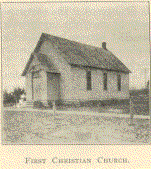 First Christian Church. |
At the expiration of eight months Reverend Fuller resigned the pastorate and Reverend T.L. Thompson was called to fill the vacancy and is the present residing pastor, dividing his time between the Concordia and Courtland churches. Reverend Thompson is a young man in years and in ministerial labors, but an earliest worker and logical speaker.
At the beginning of the Christian church organization a Sabbath school was established with E.V. King as superintendent, and although small In numbers much interest is manifested. This little church has had a struggle. They began an existence with sixteen members and within a few months - one dozen of their most active laborers transferred their residences to other quarters.
Much credit is due Professor Barings, of the Commercial College, and Miss Bertha Marlatt, county superintendent, for their zealous labors in helping to keep alive, as it were, the organization.
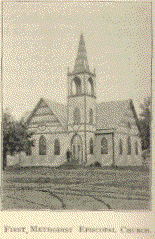 First Methodist Episcopal Church. |
The congregation now pay their minister three hundred dollars per quarter, including a comfortable parsonage. The trustees of the church are J.H. Cline, M.D. Scott, C.E. Sweet, Charles D. Avery and Willis Fish. Fully one-half of the membership was acquired during Reverend Amherst's pastorate, a net increase of one hundred members.
The church is an imposing frame structure, one of the first edifices for worship erected in Conocordia.[sic] It is situated on the corner of Seventh and Broadway. The seating capacity is about five hundred Concordia is the head of the Methodist Episcopal district and residence of the presiding elder.
Following Reverend Gray as pastor are Reverends L.A. Tallman, J.C. Dana, G.W. Wood, A.N. See, A.B. Tuttle, J.A. Bull, F.D. Baker, B.F. Stauber, H.M. Mayo, M.M. Stoltz, E.W. Allen, E.M. Evans, H.C. Amherst and Reverend Cannon. Presiding elders: James Lawrence, W.J. Mitchell, J.H. Lockwood, C.L. Shackelford, E.P. Michener, F.D. Baker, F.J. Taggart.
The congregation of the First Free Methodist church of Concordia was established in 1895 by Reverend J. Adams, with a membership of six. A modest temple of worship was erected in 1899 and dedicated in February of 1900. The dedicatory sermon was delivered by Reverend W.G. Hamner. The church is a frame building, one story in height, located on the corner of Fifth and Kansas avenue.
The growth of the organization has not been great, the present membership being but fifteen. Though small in numbers they are a faithful and devoted little band. Since 1895 the following ministers have been in charge: Reverends F. Chapman, J.E. Crawford. C.W. Long, J.H. Bacheldier and A. Helsel. The latter was compelled to retire on account of ill health and Mrs. Hill, of Cawker City, conducts services every alternate Sunday. They have a Sunday school with an average attendance of twenty pupils. Mrs. Swartz is superintendent and Miss Gertie Thomas, assistant.
The congregation of the Church of Christ at Concordia was first organized in 1875 with E.R. Jones as elder and F.M. Empson as deacon. The members at this time were meeting eight miles southeast of the city, where they continued to assemble for about fourteen years, when they moved to Concordia, assembling in various places, sometimes in private residences, until the early part of 1900, when their faith, zeal and energy prompted them to erect a neat, comfortable and pleasant place of worship on East Eighth street, where they might, as it were, "sit under their own vine and fig tree."
The congregation at the present time is composed of thirty members with E.R. Jones and A.R. Moore serving in the capacity of elders, John Townsdin and William Jones deacons. The congregation meets each Lord's day to study the scriptures and observe the communion. The gospel is frequently preached that the world may have an opportunity to hear and obey it.
A series of meetings are held once or twice each year by an evangelist, wherein numerous gospel sermons are preached, both for the benefit of the church, to strengthen it, and the world, to bring it to Christ.
The Church of Christ is of divine origin. Christ gave himself for it (Acts 20-28), hence it began from his death A.D. 33. He is the head of the corner (Math. 21-42, Acts 4: 11-12), as well as the first borne from the dead (Col. 1-18). The church is one body, composed of various members (I Cor. 12-27), with the New Testament for its creed without prefix or suffix. Each congregation divinely sent in order is independent of any other congregation of like faith, and practice, but all such assembles compose the one body (Eph. 4-4), subject to one head (Col. 1-18) and no other. Each congregation is entitled to bishops and deacons, whose qualifications are fixed by and is a part of the divine will (I Tim. 3). Every Congregation able and willing, sends the evangelist to spread the Word, establish other congregations or confirm the disciples as the case may be. The members assemble the first day of each week (Acts 20-7, Heb. 10-25) to commemorate the Lord's suffering and contribute to his cause (I Cor. 16-2).
The elders or bishops direct the spiritual part of the meeting, while the deacons attend the temporal requirements.
The Reverend Louis Mollier, whose personal history with a portrait of this venerable pioneer priest appears on these pages, and one of the first missionaries in northwest Kansas, visited the few Catholic families that had settled in the vicinity of Concordia and celebrated mass in LaRocque's hall as early as 1876. The ensuing year the foundation for a church was laid, but not completed until two years later - 1879. Reverend Joseph Perrier, who was then located at Emporia, was extended and accepted an invitation to bless the unfinished church that the pioneer Catholics might have a place to worship. The building was erected by the little band of followers and the business men of the new town who contributed liberally towards its erection and completion. In the month of July, 1880, the first resident pastor was appointed.
Rev. Joseph Perrier was assigned the place, and not having a priest's residence, he boarded in private families and assumed part of the northwestern mission work along with Father Mollier, except in the German settlements, who were provided with German speaking pastors. In 1882 the foundation for the parochial school was begun and finished ere the year closed at a cost of about four thousand dollars. The debt of something like one thousand dollars that overhung the church was paid off in 1883, and in the same year Father Perrier purchased from his personal fund a tract of ground located just east of the church, upon which to build a school. At a church meeting held in 1884, it was resolved to build a convent and academy, providing the Sisters of St. Joseph would pay half the expenses. The convent was begun directly afterward on the ground secured by their pastor and afterward deeded to the Sisters of St. Joseph by Father Perrier. The first cost of this building was six thousand dollars. Sister Stanislaus was the first Mother Superior. The academy was subsequently improved at a cost of several thousand dollars, a wing having been built on the east and a large addition to the north.
In 1884 the church was plastered, a gallery was built and furnished with new pews. In 1886 the diocese of Leavenworth was considered too large for one bishop and it was decided by the ecclesiastical authorities to divide the state into three dioceses with the Episcopal See at Leavenworth, Wichita and Concordia. To help further these interests and at the suggestion of Bishop Fink, Father Perrier called for a meeting of the citizens to convene in LaRocque's hall for the purpose of ascertaining how much could be accomplished in the way of raising funds to be applied on city property for future emergencies. The citizens of Concordia, irrespective of faith or creed, responded generously and five thousand dollars was subscribed.
Early in September, 1887, the Right Reverend R. Scannell, a divine and profound scholar, was elected the first bishop of Concordia. June 6, 1888, on the occasion of his silver jubilee, Father Perrier was created vicar general over the diocese of Concordia. During that year he visited Europe and received from there financial aid to be applied to the diocese, and upon his return the bishop's home was added to, remodeled, refurnished and converted into a palatial residence, fitted with modern conveniences, electric lights, bath rooms, telephones, etc., superior in its appointments to many richer dioceses.
Bishop Scannell was appointed to the more important see at Omaha, and in 1891 Bishop Hennessy, of Wichita, was appointed administrator and during his reign the diocese was on the verge of collapse and many petitions were sent to Rome by the citizens of Concordia, praying that a new bishop be appointed. Notwithstanding the advice of the pastor to take on courage and hope for better times, one hundred and seventy-four Catholic families removed from the Concordia parish during the hard years occasioned by repeated crop failures and more than eight thousand Catholic people left this diocese, which comprises thirty-one counties. Father Perrier advised them to forbear, and as a precedent alluded to the seven years of famine in Egypt, followed by the same number of years of plenty. Of those who left many have expressed regret; those who remained are a contented and satisfied people.
In 1898 the priests, consulters of the diocese and the bishops of the province of St. Louis convened by the request of Holy Father Leo XIII, for the selection of a new bishop for Concordia, and accordingly, on the 21st of September, Father J.V. Cunningham, the vicar general of the Leavenworth diocese, was consecrated bishop of Concordia. Bishop Cunningham is a true Kansan, taking into his personality the true enterprising spirit that distinguishes the people of the state. He is a man of unassuming manner, but a promoter of many important enterprises since his residence in Concordia. Several fine churches and new school buildings are under course of construction. As early as 1860 he was a student in St. Benedict's College, Atchison, Kansas. From there he entered upon a theological course in Milwaukee, was ordained a priest in 1865 and sent to Fort Scott, Kansas, where he experienced many privations and arduous labor. Railroad facilities were meager and necessitated the mode of travel largely of horse-back riding.
In 1868 Bishop Cunningham was sent to Lawrence, where Father Perrier had preceded him two years. It was in this city that Father Cunningham demonstrated his great administrative powers, executive ability and building capacity, erecting edifices that are monuments to his zeal and energy. From Lawrence he was stationed at Topeka, where he built a commodious and handsome church that is in use at the present day. He also labored hard for the education of the youth and is an earnest advocate of superior learning. From Topeka he was called to the city of Leavenworth, was made vicar general soon afterward, and subsequently bishop of Concordia, accepting the latter after positively refusing other important dioceses in larger cities.
In the year of 1901 plans and specifications were perfected for building a cathedral. Work begun in the spring of 1901 and from a modest house of worship a magnificent cathedral has developed. It would seem nearly all of the citizens of Concordia were desirous of being identified with the effort on the part of the church to erect a cathedral that would be a monument of pride and credit to the see, also to the city of Concordia, and an honor to the members of the parish. Catholics and Protestants alike manifested their good will and generosity in this well merited enterprise.
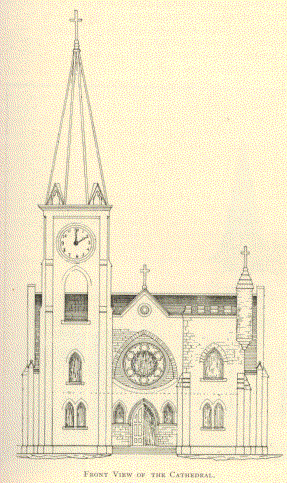
First View of the Cathedral
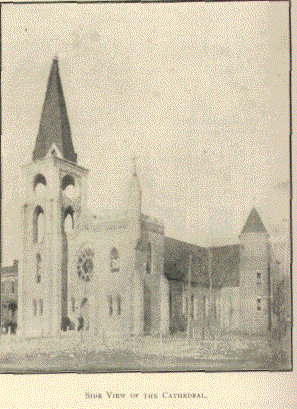
Side View of the Cathedral
The rosette window in the front of the cathedral and at the back of the choral gallery is a magnificent execution of art, a memorial by St. Joseph's Nazareth Academy. In the center is a life-size figure of the beautiful St. Cecelia, playing the pipe organ. The delicate features of this sainted character are exquisitely outlined and the coloring is superb. Above this central figure to the right and to the left are the initials C.F., representing the donors, the Catholic Foresters of Concordia. This window was secured at a cost of about five hundred dollars. Between the initials and above the center is a cross, the emblem of the altar with the words, Faith, Hope and Charity inscribed on each branch, and upon the face of the cross is wrought the figure of an elk, which is part of the emblem of the society. On the right of the center is a harp of David, and on the left, a cross. Below and on the right side is the bishop's crozier and on the corresponding left side, a mitre. The principal memorial on the west transept is a portrayal of the holy family, Jesus, Mary and Joseph. The figures are full size exquisitely produced. As one changes position the figures, lines in the tiling and the whole scene shifts accordingly, appearing the same from any given point.
The widow on the opposite side from the one just described is a beautifully wrought design of John the Baptist, baptizing in the limpid waters of the river Jordon. This imposing memorial was presented by the congregation in honor of Bishop Cunningham. Another and one of the most suggestive is the window presented by Michael Priest, the little four-year-old son of Doctor and Mrs. Priest, of Concordia, illustrating the arch-angel casting out the dragon. The second represents St. Patrick explaining the Holy Trinity to the people of Ireland, who were congregated before Thara's Hall. The patron saint holds a shamrock in his hand plucked from among the profusion that were growing all around his pathway, and is demonstrating thereby the unity represented by its three leaves as symbolical of the Father, Son and Holy Ghost. This artistic memorial was given by the Irish members of the congregation. Upon the opposite side is an attractive window, not only for its artistic beauty, but for the beautiful sentiment that is attached, having been given by the pastor, Father Perrier, in memory of his mother, Patronilla. The design represents St. Peter with the key to the kingdom of heaven, a smybol[sic] of the scripture which says, "Whatsoever thou shall bind upon earth shall be bound also in heaven; whatsoever thou shall lose upon earth shall be lost also in heaven."
Next to this window is depicted in beautiful soft coloring St. Francis DeSales, given by A. Odette, a memorial to his deceased wife. There are many other windows presented by the Children of Mary, altar societies and members of the congregation, each of which are deserving of mention if space permitted. Speaking of them collectively, no one can realize the magnificence and superb beauty of these triumphs of art without making an individual study of each and if they had been imported from Europe instead of being created by Warner, of Kansas City and painted by a German-American artist, they would have cost a fabulous sum and been pronounced marvelous. The day is dawning when it must be conceded America can furnish talent and genius not excelled by the European countries.
Arranged on either side of the walls of the audience room are fourteen bas-reliefs, representing the passions of our Lord as mentioned in each of the last chapters of the gospel. These are the gifts of Father Perrier.
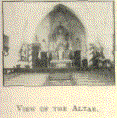
View of the Altar.
The altar, manufactured by the Ferring Company, of Chicago, and presented by Father Maine and the bishop, is a composition of natural butternut wood and gold with agate columns. Its exquisite beauty cannot be described. Much of the decoration is in gold leaf and that part alone was procured by an outlay of something like three hundred dollars. The burnished gold was applied by the manufacturers. Within the enclosure of the sanctuary is the bishop's throne, and seldom is one so rich and, elegant in its equipment witnessed in this country. The main and side altars, gorgeous with gold and precious stones, bishop's throne, bas-relief and the ceiling are all carried out in the same Gothic style of architecture, making one grand harmonious whole a perfect unity.
The beautiful statuary on the right is the Sacred Heart of Jesus. The emblem of this figure is Jesus burning with love for the salvation of mailkind. The coloring in this figure is particularly soft, the drapery falling in long, graceful folds. It is exquisitely designed and exceedingly beautiful. On the left is St. Ann, the mother of Mary, teaching her beloved child to read the scriptures inscribed on the piece of parchment which she holds in her hands. The altars containing them are of the same Gothic design. Above the tabernacle of the sanctuary is the statue of Norte Dame Bonsecours, or our Lady of Perpetual Health. To the right rests the statue of St. Joseph, the foster father of Jewus, and on the left, St. Anthony, holding the child Jesus tenderly in his arms. On each side there are two angels in adoration before the altar, as God described the churches should be made, In a recess at the base of the altar the Lord's Supper is depicted in statuary. The handsome carpet which harmonizes with the other furnishings of the sanctuary was given by the Ladies of the Sacred Heart Altar and St. Ann societies.
The sacristy or dressing room, and where the sacraments and sacred vessels are kept, lies just back of the sanctuary. The dimensions of this room are thirty-seven feet. The seating capacity of the cathedral is ordinarily eight hundred, but if the occasion demands, twelve hundred could be seated. The cathedral has cost as it stands about thirty-two thousand dollars. As soon as the walls are in condition they will be frescoed at an additional cost of from two to three thousand dollars. When this enterprise was first taken under consideration the consummation seemed an impossibility, but through the energy of the pastor, Father Perrier, and the bishops, it has been accomplished.
![]()
Transcribed from E.F. Hollibaugh's Biographical history of Cloud County, Kansas biographies of representative citizens. Illustrated with portraits of prominent people, cuts of homes, stock, etc. [n.p., 1903] 919p. illus., ports. 28 cm.
New Index
A | B | C | D | E | F | G | H | I | J | K | L | M | N | O | P | Q | R | S | T | U | V | W | Y | Z
